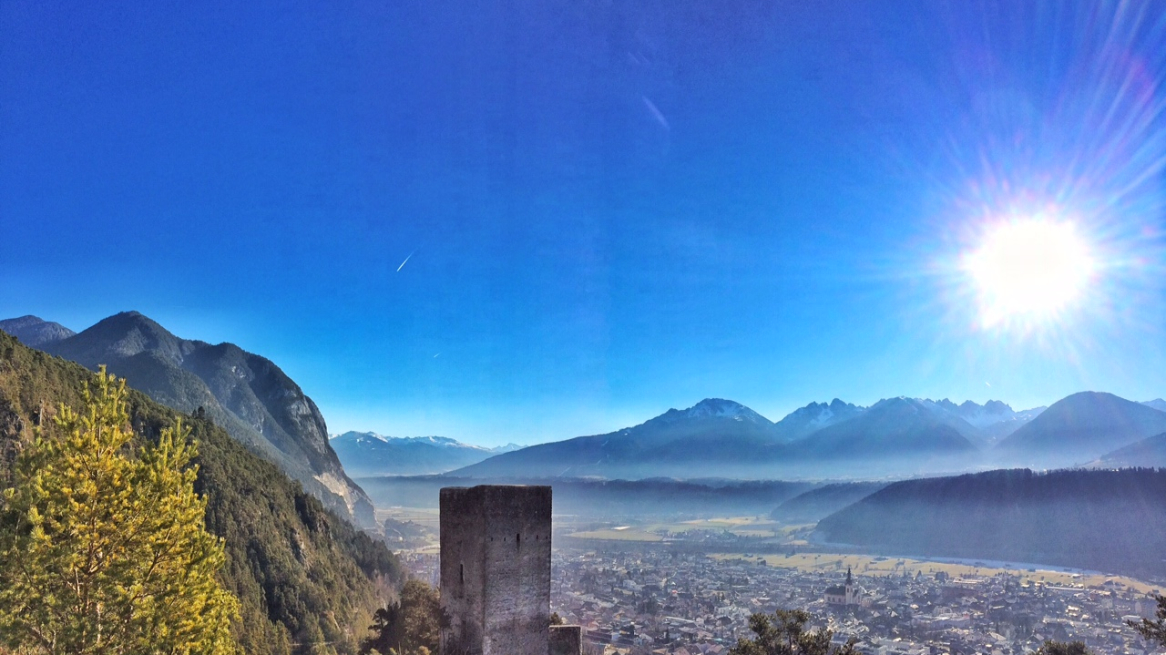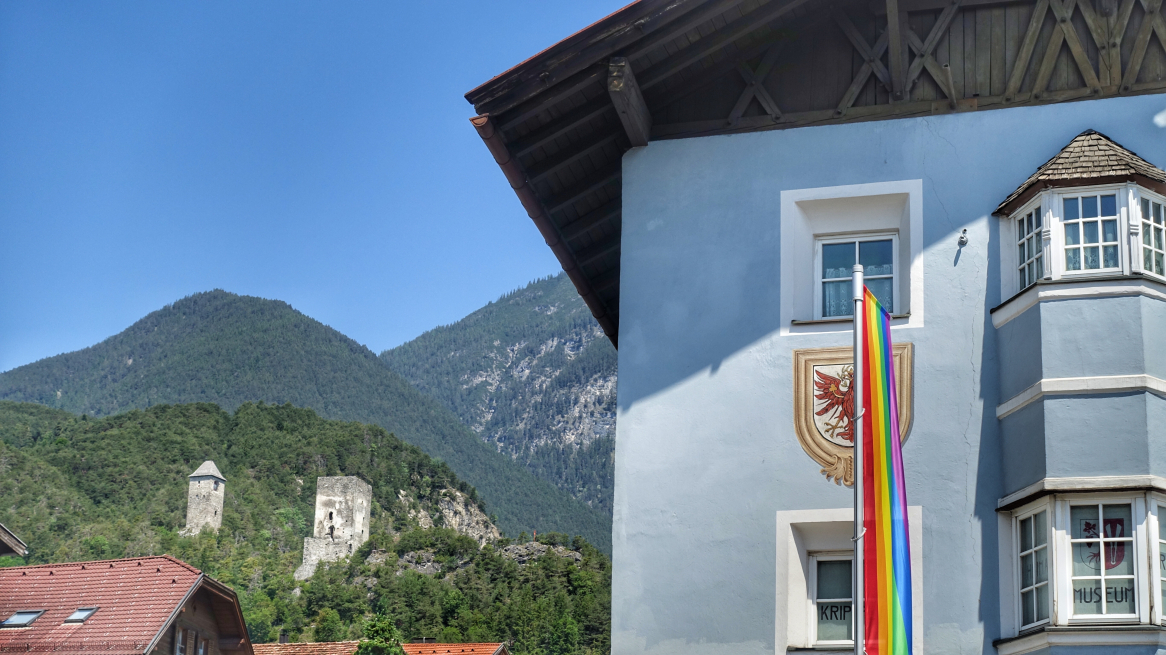
Two ruinous towers towering high above Zirl are the pitiful remains of a once important castle and palace complex. Emperors and kings, and sometimes even famous minstrels, stayed here. Fragenstein was undoubtedly one of the most popular and noble castles in Tyrol, especially during the reign of Emperor Maximilian I.
If you had asked the common people back then what the name 'Fragenstein' meant to them, they would have answered with eyes wide open in fear. Because when Fragenstein was founded around 1200, the castle was also the seat of justice. The word 'Frag' stood for 'interrogation' back then. And as there was little squeamishness in the Middle Ages, even a simple interrogation was usually an 'embarrassing questioning', i.e. the code for brutal torture. The castle's current name would therefore be 'torture stone'.
Sebastian Scheel, Fragenstein on a watercolor pen drawing from around 1550, repro from 'Tiroler Burgenbuch'
When Meinhard II bought the castle around 1284 and incorporated it into 'his Tyrol', he killed two birds with one stone: the castle was located on the busy medieval trade route from Innsbruck via Seefeld to southern Germany, which promised a lucrative toll income. In addition, the stag and chamois hunts of the time were virtually right outside the castle gate. This meant that the aristocratic high hunt could celebrate a happy holiday at any time. Due to its highly visible location, the castle was also used as a Chalk fire station predestined. Such high-altitude fires were a form of communication over long distances in times of crisis. So Fragenstein was aware of threatening events early enough.
A medieval 'pop star' struck the lyre in Zirl
Fragenstein earned its reputation as one of the noblest Tyrolean castles through the presence of the most famous of all minnesingers at the time: Oswald von Wolkenstein. Family connections lured the medieval singing star to Zirl twice: in 1419 and 1426, he honored his brother-in-law Parzival II von Weineck with his visit, during which he certainly struck the lyre. however, 1426 was the year when the fun at Fragenstein came to an end. A process began which ended in 1429 with Frederick IV being allowed to force the rebellious Parzifal to sell the castle 'with an empty pocket'. From then on, the respective Tyrolean prince was the owner of the castle. He in turn could appoint caretakers to administer it.
Maximilian thwarted the sale of the castle to the Bavarians
The castle-like complex experienced its most glamorous period in the years after it was virtually assigned to Siegmund the Rich in Coin as Tyrolean sovereign in 1446. The womanizer, who was always in need of money - he allegedly fathered dozens of illegitimate children - began to use the castle as the starting point for glamorous hunts. (I have described Siegmund's penchant for the unusual here described here) Unfortunately, he wanted to solve his permanent financial difficulties by pledging some of his possessions to the Bavarian dukes. However, his cousin Emperor Frederick III, and above all his son Maximilian, thwarted this plan, granted him an annuity and took over Siegmund's possessions without further ado. Of course, in return for the assurance that he would be allowed to continue hunting and fishing on his former territories, which was very important to him. From then on, Fragenstein was to experience a period of prosperity. A virtual 'reconstruction' gives an impression of the complex.
Chancellor Zyprian von Sernthein takes over the castle
March 16, 1490 marked the beginning of the meteoric rise of a man who would even turn Fragenstein into a kind of 'administrative center' of the Habsburg Empire in the years that followed. On this day, Maximilian officially became the ruler of Tyrol. He made a certain Zyprian von Sernthein his closest confidant as 'chancellor'. The man, who came from a South Tyrolean noble family, became an indispensable helper and advisor to Maximilian over the following years. On January 8, 1498, Maximilian promoted Zyprian von Sernthein to caretaker of the castle. This was tantamount to having power of disposal over the walls. He oversaw the renovation and expansion of the castle, which had become one of Maximilian's favorite bases for magnificent hunting expeditions. Remarkably, Sernthein paid for some of the extension and improvement work out of his own pocket because craftsmen no longer gave the emperor credit, as the emperor had a policy of not paying bills. And so the chancellor had to grant his emperor an advance, so to speak, to ensure that the renovation work went ahead at all.
Fragenstein now became Maximilian's favorite hunting seat. The 'Court of Hörtenberg', to which Fragenstein Castle belonged, had four deer and 16 chamois hunting grounds at the time. Interesting in this context: Maximilian regarded hunting as a kind of 'training' to keep fit. He was also able to prove his personal courage to potentates, diplomats and the high nobility with these bold undertakings. Many hunts took place as 'show hunts', where all sorts of non-hunting spectators were able to marvel at the daring huntsmen's wild voltes in the bare rock.
In Maximilian's time, chamois had to be 'stabbed' out of the wall with a pike. Maximilian refused to 'shoot' them with a bow and arrow or even a crossbow.
I would like to briefly mention two events that demonstrate Maximilian's intentions in connection with hunting. One of them took place on July 24, 1497 on the Herzogswiese in Stams. In honor of the Turkish sultan, or more precisely his personal envoy - he had agreed to a truce with Maximilian - stags were released in the Stams area. The envoy shot a stag in Turkish style with a throwing spear. After the hunt, they dined in tents and held an audience. However, the envoy of the Duke of Milan, who had also been invited, noted with a sniff that the Turkish representative was very uncultured. And as he supposedly went to bed wearing shoes, he would not have found suitable accommodation in Innsbruck. At Fragenstein, they obviously didn't want to accommodate the gentleman at all.
Maximilian had direct visual contact with the Martinswand from Fragenstein. He celebrated show hunts there. Picture: W. Kräutler
Fragenstein Castle with a view of the Martinswand in a lithograph by Podesta around 1840. 'View from the Zirlberg', Ferdinandeum Innsbruck
It is logical that Fragenstein was also the starting point for Maximilian's most famous hunting adventure: his legendary chamois hunt in the Martinswand. In Maximilian's biography, it was later transformed into a 'judgment of God', so to speak. I have already described the hunting trip and Maximilian's penchant for self-promotion described here.
It is worth mentioning in this context that Maximilian demanded that chamois could not be hunted with a bow and arrow or a crossbow. The animals had to be 'stabbed out of the wall' with spears. If one imagines that today's mostly corpulent hunters had to scramble around on rock faces, the number of hunter casualties would be much higher than that of the chamois.
Despite its popularity, we should not imagine that Fragenstein was a luxurious castle in Maximilian's time. The emperor preferred to invest in wars and lived - by necessity - relatively spartanly in his castles and palaces. Maximilian's castles and palaces were usually less lavishly furnished than the castles of minor Italian princes, for example. Fragenstein did not really offer any luxury. Maximilian's court was also used to spartan accommodation. The hundreds of companions were constantly on the move with him and sometimes had to stay in modest hunting lodges. Due to a lack of space, it could happen that the entourage had to make do with surrounding private houses and farmhouses or even tent camps.
Maximilian was permanently 'broke'
The greatest challenge for Zyprian von Sernthein was certainly to help Maximilian out of his permanent financial difficulties. When Maximilian could no longer obtain loans because he refused to repay them on principle, Sernthein had to find a way. For a long time, it was he who granted Maximilian personal loans. This went well until his personal creditworthiness was also 'on the dog' and he was no longer 'creditworthy'. Cyprian did not receive any monetary repayments from Maximilian either, as the emperor's coffers were always empty due to his pompous appearances and his wars. In return, Cyprian received fiefs, such as Runkelstein Castle near Bolzano, which he was assigned to look after. However, he was also active in the silver, oxen and cloth trade and other businesses, which made him one of the emperor's biggest lenders and guarantors.
And if all else failed, there were still the 'emergency helpers' lurking in the background in the form of the stinking rich Fugger dynasty. In return for all kinds of transfers of mines or other lucrative deals, they usually came to Maximilian's aid at the last moment.
Until it was blown up by Zirler Schützen, Fragenstein was of course also a toll station for the lucrative salt trade, in which Zirl played an important role. Picture: W. Kräutler
What is less well known is that Fragenstein was practically the administrative center of the Habsburg Empire at the time of Maximilian. Zyprian von Sernthein resided here, but above all he had the files stored at Fragenstein and not in the archives in Innsbruck. Maximilian held Sernthein in high esteem. This can be seen above all from the fact that he was involved in various, sometimes complicated diplomatic activities and represented Maximilian's interests perfectly. Sernthein's role in the 'Peace of Basel'when it came to ending the Swiss wars.
The maintenance of the castle became a real problem after Maximilian. Permanent repairs required large sums of money. Parts of the castle were so neglected that they were barely habitable.
The castle fell into noticeable disrepair. Johann Richter recorded its condition in the middle of the 19th century.
Zirler marksmen blew up the castle
The final decline of Fragenstein began on July 23, 1703 with the 'Bavarian Rummel'. The Bavarians had a bone to pick with the Habsburgs and invaded Tyrol. The Zirler Schützen, part of the Tyrolean troops, retreated to Fragenstein, but could no longer withstand the oppressive superiority. They finally blew up the castle, which was left to decay from then on.
The decaying walls were also used as a quarry in Zirl, as was customary at the time. The Austrian Castle Association began the first work to secure the castle in 1933. Between 1974 and 1978, total decay was halted and the ruins were restored.
My tips on the topic
A visit to the ruins is possible from the center of Zirl after a walk of around half an hour. For readers who want to find out more about the castle and its history, there are two tips:
- A highly interesting account of the castle in Maximilian's time can be found in a thesis by Nikolaus Adam Grotenburg: "Kaiser Maximilian I, Zyprian von Serntein und Schloss Fragenstein bei Zirl".
- The "Tiroler Burgenbuch, Band 6 - Mittleres Inntal" (Athesia) contains details of the building history.
Rate this article
Show me the location on the map
A volunteer at the "Schule der Alm" alpine farming school, cultural pilgrim, Tyrol aficionado and Innsbruck fan.
Similar articles
Get Ready to Celebrate Attention Innsbruck! Get ready for the vibrant return of the Alles…
Innsbruck is the perfect size for exploring on foot. We walked from Bergisel to Hungerburg and took…
Innsbruck is really good at beauty! But where a building site is currently disrupting the…
Innsbruck is a popular tourist destination. The big attraction remains the mountains, but the city has a…













